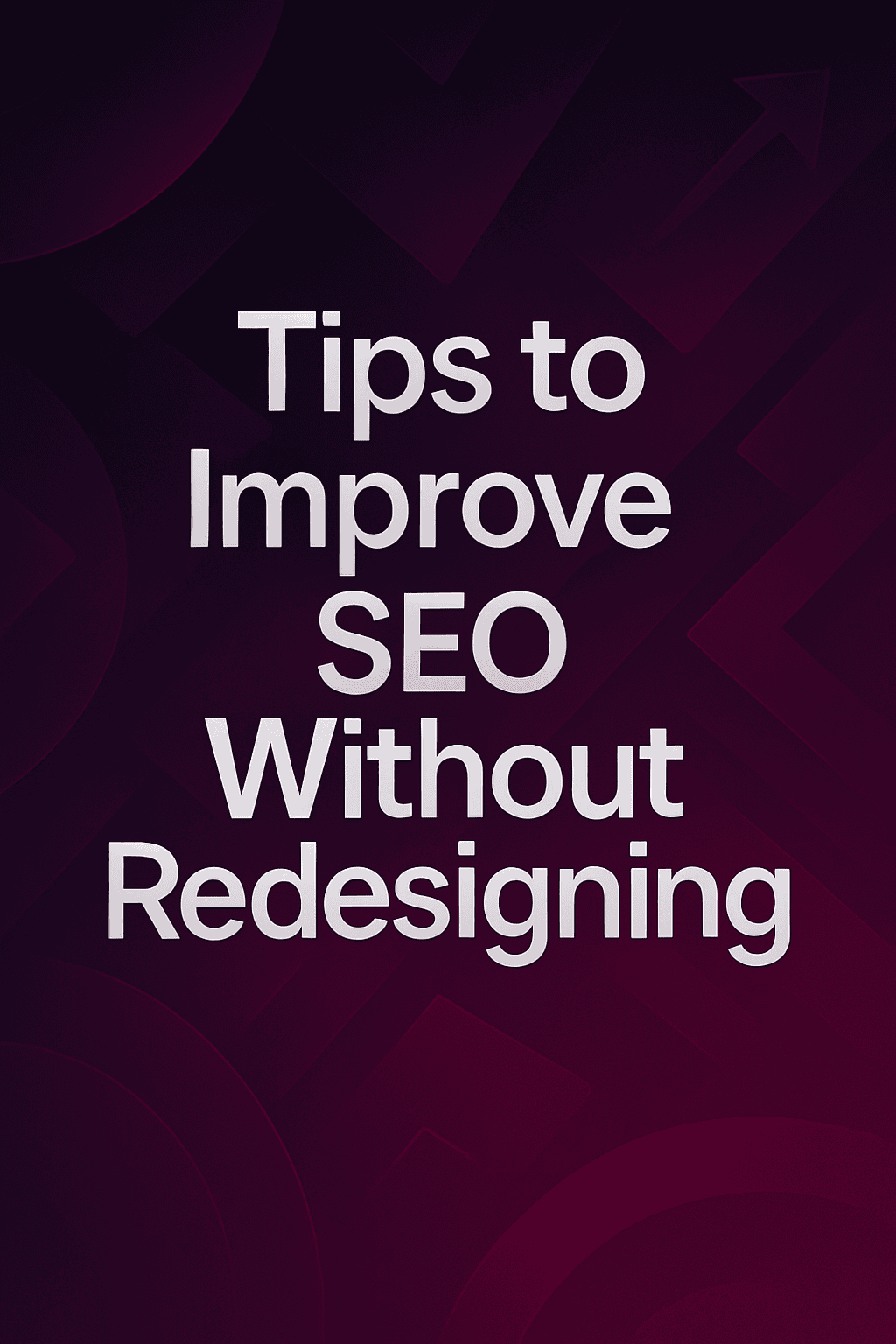
You don’t always need a full website redesign to start seeing results on Google. In fact, some of the best SEO gains come from small, strategic tweaks. Whether you’re working with a site you love (or at least one that’s “good enough for now”), there’s a lot you can do under the hood to bring in more qualified traffic.
Let’s walk through practical, tested tips to improve your site’s SEO—without touching the design.
What This Post Covers
- Why design isn’t always the problem
- 15+ actionable SEO improvements
- How to test what’s working
- What to avoid
- When to finally consider a redesign
You Can Get SEO Results Without a Full Redesign
A redesign might be necessary eventually, but here’s the truth: SEO is mostly about content, structure, speed, and relevance—not just how your site looks. We’ve helped businesses see dramatic gains simply by cleaning up backend issues and improving existing content.
If your site is technically sound and not completely outdated, optimizing what’s already there is often a faster, more affordable path to better rankings and conversions.
1) Start with a Manual SEO Audit
Before jumping into changes, you need a clear picture of what’s holding your site back.
What to check:
- Are your most important pages indexed?
- Is your content aligned with what people are searching for?
- Do your page titles and meta descriptions make sense?
- Are you getting traffic but no conversions?
💡 Tip: Request a manual audit if you’re not sure what to look for. We review sites like real users and real search engines—not just with tools.
2) Improve Your Page Titles (Don’t Just Stuff Keywords)
Many sites still use homepages titled “Welcome” or “Home.” That doesn’t help Google (or anyone).
Bad:
Home | ABC Company
Better:
Graphic Design & Web Services in Longview WA | ABC Company
Think:
- Specific
- Clear
- Targeted to what users are searching for
3) Write Unique Meta Descriptions for Each Page
These aren’t a ranking factor, but they do affect click-through rates. A good meta description encourages people to click your result instead of a competitor’s.
Do:
- Keep it under 160 characters
- Write naturally
- Include a call to value (not a call to action unless you’re targeting ads)
4) Use H1 and H2 Headings Properly
Many older sites still don’t use proper heading structure. This confuses both Google and users.
Make sure each page:
- Has one
<h1>(the main page title) - Uses
<h2>s to break up sections - Avoids skipping heading levels (e.g., no jumping from H2 to H4)
Headings should reflect what the section is about—and include keywords where natural.
5) Optimize for Real Search Queries
Instead of guessing what people type into Google, use tools like:
- Google Search Console (what queries are already bringing in traffic?)
- Answer the Public
- Ahrefs or Semrush (if available)
Then weave those exact phrases naturally into:
- Headings
- Subheadings
- Paragraphs
- Image alt text
6) Add Internal Links (Strategically)
Link to other pages on your site where it makes sense. This:
- Helps Google crawl your site
- Passes SEO value between pages
- Keeps users engaged longer
✅ Tip: Always use descriptive anchor text (e.g., “see our web design process,” not “click here”).
7) Make Existing Content More Useful
Google rewards content that actually answers people’s questions.
Go through old blog posts and:
- Add updated data or insights
- Answer follow-up questions
- Include images, examples, or quotes
- Break up long paragraphs for readability
This is a quick way to boost rankings for pages that already get some traffic but aren’t ranking as high as they could.
8) Use Schema Markup (Especially on Homepage)
Schema helps search engines understand your content better. Start simple.
Add:
Organizationschema on your homepageFAQschema on FAQ pagesProductschema on product pages (if eCommerce)
💡 Here’s a guide on implementing schema manually or via plugins in WordPress + Elementor.
9) Fix Crawl Errors and Broken Links
404 pages and broken internal links waste SEO value and frustrate visitors.
Check Google Search Console or run a tool like Screaming Frog. Fix:
- Internal broken links
- Incorrect redirects
- Orphaned pages (pages not linked anywhere)
10) Speed Up Your Site (Without Redesigning)
Performance is a ranking factor. Here’s what to do without touching the design:
- Compress images (use WebP)
- Enable server-level caching
- Use a CDN (like Google Cloud CDN or Cloudflare)
- Minify JS/CSS
- Lazy load images
✅ Tip: Graticle Hosting includes built-in CDN, daily backups, and caching tuned for SEO. Learn more here.
11) Add Location-Specific Content (Even If You’re National)
Local SEO is powerful—even for companies with broader reach. Add city or region references naturally on core pages and blog posts.
Examples:
- “Serving Longview and the surrounding areas”
- “Trusted by businesses across the Pacific Northwest and beyond”
Make sure your Google Business Profile is claimed, accurate, and linked to your site.
12) Optimize Your Images (Beyond File Size)
Also include:
- Descriptive alt text (for accessibility and image search)
- File names like
web-design-longview.jpginstead ofIMG_3432.jpg - Structured captions where it makes sense
This helps SEO and user experience.
13) Add or Improve Your Blog
If you haven’t posted in a while, Google might assume your site is inactive.
Try:
- Publishing once or twice a month
- Targeting specific questions or keyword clusters
- Updating older posts for freshness (don’t just publish new)
👉 Example Post: Tips to Make Your Website Easier to Use Without Redesigning
14) Add FAQs With Schema
If you keep answering the same questions for clients, turn those into an FAQ section—preferably marked up with schema.
This:
- Helps you show up in “People also ask”
- Improves mobile usability
- Builds trust and authority
15) Improve Conversion Points
All the traffic in the world won’t help if users don’t take action.
Improve:
- Contact forms (simplify and label clearly)
- CTA placement (above the fold and at the bottom)
- Navigation (clear, minimal, prioritized)
Don’t forget to check mobile usability.
Bonus: Update Your Footer for SEO
Your footer is a great place to add:
- Address or service area info
- Links to top service pages
- Social media profiles
- A mini sitemap with priority pages
But keep it uncluttered—think hierarchy, not kitchen sink.
How to Track Your SEO Improvements
Use Google Search Console and Google Analytics to monitor:
- Organic impressions
- Click-through rate (CTR)
- Ranking positions for target keywords
- Time on page and bounce rates
Track before/after implementing any change.
✅ Pro tip: Keep a simple spreadsheet log of what you changed and when.
What NOT to Do
Avoid:
- Keyword stuffing
- Buying backlinks
- Publishing tons of thin content
- Ignoring technical SEO
- Relying only on AI-generated content without editing
Google gets smarter every day—focus on value.
When You’ll Eventually Need a Redesign
Optimizations go a long way, but sometimes design is holding you back. If:
- Your site isn’t mobile responsive
- Pages take over 5 seconds to load
- Navigation is confusing or outdated
- Branding doesn’t match who you are anymore
…it might be time to chat redesign. But that’s another post (or check out Don’t Redesign Blind—Here’s How to Test First).
Need Help Getting Started?
If you’d rather not piece all this together yourself, we’ll take a look at your site and give you real, actionable advice.
💬 Request a Manual Website Audit
We’ll let you know what’s working, what’s hurting your SEO, and what you can fix without touching your design.
Final Thoughts
You don’t need a new website to get more traffic. Start with what you’ve got. Fix the things you can control. And if or when the time comes to redesign, you’ll already have a strong SEO foundation to build on.





